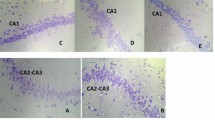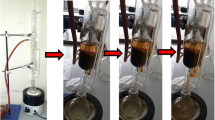We investigated the effects of a concentrate of green tea (extract of Camellia sinensis) on passive avoidance learning and hippocampal neurogenesis in male Wistar rats. Twenty-one male rats were divided into control, sham, and experimental groups. Rats of the control group were left intact, sham rats received infusions of 1.0 ml of distilled water for 8 weeks, while experimental rats received 1.0 ml of brewed green tea with a concentration of 0.04 g/ml. After eight weeks and behavioral testing, brain samples were taken, and 6-μm-thick sections were prepared from the hippocampus and examined microscopically using hematoxylin+eosin staining. Results of the passive avoidance tests confirmed improved learning after green tea concentrate administration (P < 0.01). Treatment of the experimental group by the extract increased noticeably the density (number per test area) of neurons (intensity of neurogenesis) in the CA3 area and dentate gyrus of the hippocampus (P < 0.001).
Similar content being viewed by others
References
H. Bading, “Nuclear calcium signalling in the regulation of brain function,” Nat. Rev. Neurosci., 14, 593-608 (2013).
E. R. Kandel, “The molecular biology of memory storage: a dialogue between genes and synapses,” Science, 294, 1030-1038 (2001).
E. M. Robbins, A. J. Krupp, K. Perez de Arce, et al., “SynCAM 1 adhesion dynamically regulates synapse number and impacts plasticity and learning,” Neuron, 68, 894-906 (2010).
Y. Wang, M. Li, X. Xu, et al., “Green tea epigallocatechin-3-gallate (EGCG) promotes neural progenitor cell proliferation and sonic hedgehog pathway activation during adult hippocampal neurogenesis,” Mol. Nutr. Food Res., 56, 1292-1303 (2012).
M. N. Beidokhti and D. Prakash, “Antioxidant and antiinflammatory potential of selected medicinal plants of Lamiaceae family,” Int. J. Pharm. Sci., 5, 100-104 (2013).
A. R. Shiksharthi, S. Mittal, and J. Ramana, “Systematic review of herbals as potential memory enhancers,” Int. J. Res. Pharm. Biomed. Sci., 2, 918-925 (2011).
T. Kaur, C. Pathak, P. Pandhi, and K. Khanduja, “Effects of green tea extract on learning, memory, behavior and acetylcholinesterase activity in young and old male rats,” Brain Cogn., 67, 25-30 (2008).
H. F. Ji, X. J. Li, and H. Y. Zhang, “Natural products and drug discovery,” EMBO Reports, 10, 194-200 (2009).
K. M. Yoo, C. H. Lee, H. Lee, et al., “Relative antioxidant and cytoprotective activities of common herbs,” Food Chem., 106, 929-936 (2008).
J. Sharma, R. Chawla, R. Kumar, et al., Camellia Sinensis as a Safe Neuroprotective Radiation Countermeasure Agent.
H. N. Graham, “Green tea composition, consumption, and polyphenol chemistry,” Prevent. Med., 21, 334-350 (1992).
S. M. Chacko, P. T. Thambi, R. Kuttan, and I. Nishigaki, “Beneficial effects of green tea: a literature review,” Chin. Med., 5, 1-9 (2010).
K. G. Akers, A. Martinez-Canabal, L. Restivo, et al., “Hippocampal neurogenesis regulates forgetting during adulthood and infancy,” Science, 344, 598-602 (2014).
C. Astill, M. R. Birch, C. Dacombe, et al., “Factors affecting the caffeine and polyphenol contents of black and green tea infusions,” J. Agricult. Food Chem., 49, 5340-5347 (2001).
K. Sonoda, W. Aoi, T. Iwata, and Y. Li, Anthocyanin-Rich Aronia Melanocarpa Extract Improves Body Temperature Maintenance in Healthy Women with a Cold Constitution, Vol. 2, Springer Plus (2013).
T. C. Wallace, “Anthocyanins in cardiovascular disease,” Adv. Nutr. (Int. Rev. J.), 2, 1-7 (2011).
R. F. Thompson and J. J. Kim, “Memory systems in the brain and localization of a memory,” Proc. Natl. Acad. Sci. USA, 93, 13438-13444 (1996).
M. L. Duennwald and J. Shorter, “Countering amyloid polymorphism and drug resistance with minimal drug cocktails,” Prion, 4, 244-251 (2010).
A. Dulloo, J. Seydoux, L. Girardier, et al., “Green tea and thermogenesis: interactions between catechinpolyphenols, caffeine and sympathetic activity,” Int. J. Obesity, 24, 252-258 (2000).
A. G. Dulloo, C. Duret, D. Rohrer, et al., “Efficacy of a green tea extract rich in catechin polyphenols and caffeine in increasing 24-h energy expenditure and fat oxidation in humans,” Am. J. Clin. Nurt., 70, 1040-1045 (1999).
H.-S. Kim, M. J. Quon, and J.-A. Kim, “New insights into the mechanisms of polyphenols beyond antioxidant properties; lessons from the green tea polyphenol, epigallocatechin 3-gallate,” Redox Biol., 2, 187-195 (2014).
K. Landis-Piwowar, D. Chen, R. Foldes, et al., “Novel epigallocatechin gallate analogs as potential anticancer agents: a patent review (2009-present),” Exp. Opin. Ther. Patents, 23, 189-202 (2013).
A. Mähler, S. Mandel, M. Lorenz, et al., “Epigallocatechin-3-gallate: a useful, effective and safe clinical approach for targeted prevention and individualised treatment of neurological diseases?” Epma J., 4 (2013).
S. A. Mandel, T. Amit, O. Weinreb, et al., “Simultaneous manipulation of multiple brain targets by green tea catechins: a potential neuroprotective strategy for Alzheimer and Parkinson diseases,” CNS Neurosci. Ther., 14, 352-365 (2008).
K. Unno, H. Yamamoto, T. Ohtaki, et al., “Active component in green tea catechins and effective intake period for prevention of age-related brain dysfunction,” Anti-aging Med., 8, 75-81 (2011).
A. Schmidt, F. Hammann, B. Wölnerhanssen, et al., “Green tea extract enhances parieto-frontal connectivity during working memory processing,” Psychopharmacology, 231, 3879-3888 (2014).
M. Gomez-Ramirez, S. P. Kelly, J. L. Montesi, and J. J. Foxe, “The effects of L-theanine on alpha-band oscillatory brain activity during a visuo-spatial attention task,” Brain Topography, 22, 44-51 (2009).
T. Kakuda, A. Nozawa, A. Sugimoto, and H. Niino, “Inhibition by theanine of binding of [3H] AMPA,[3H] kainate, and [3H] MDL 105,519 to glutamate receptors,” Biosci., Biotechnol. Biochem., 66, 2683-2686 (2002).
R. Mason, “200 mg of Zen: L-theanine boosts alpha waves, promotes alert relaxation,” Alternat. Complement. Ther., 7, 91-95 (2001).
S. P. Kelly, M. Gomez-Ramirez, J. L. Montesi, and J. J. Foxe, “L-theanine and caffeine in combination affect human cognition as evidenced by oscillatory alpha-band activity and attention task performance,” J. Nutr., 138, 1572S-1577S (2008).
M. Marder and A. C. Paladini, “GABA-A-receptor ligands of flavonoid structure,” Current Topics Med. Chem., 2, 853-867 (2002).
M. R. Zarrindast, “Neurotransmitters and cognition,” in: Neurotransmitter Interactions and Cognitive Function, Springer (2006), pp. 5-39.
D. Borota, E. Murray, G. Keceli, et al., “Post-study caffeine administration enhances memory consolidation in humans,” Nat. Neurosci., 17, 201-203 (2014).
B. B. Fredholm, “Adenosine, adenosine receptors and the actions of caffeine,” Pharmacol. Toxicol., 76, 93-101 (1995).
A. Nehlig, J.-L. Daval, and G. Debry, “Caffeine and the central nervous system: mechanisms of action, biochemical, metabolic and psychostimulant effects,” Brain Res. Rev., 17, 139-170 (1992).
C. Ruxton, “The impact of caffeine on mood, cognitive function, performance and hydration: a review of benefits and risks,” Nutr. Bull., 33, 15-25 (2008).
J. P. Spencer, “Flavonoids and brain health: multiple effects underpinned by common mechanisms,” Gen. Nutr., 4, 243-250 (2009).
B. V. Zlokovic, “Neurovascular pathways to neurodegeneration in Alzheimer’s disease and other disorders,” Nat. Rev. Neurosci., 12, 723-738 (2011).
S. Kuriyama, A. Hozawa, K. Ohmori, et al., “Green tea consumption and cognitive function: a cross-sectional study from the Tsurugaya Project,” Am. J. Clim. Nutr., 83, 355-361 (2006).Acernatemquo qui nobis sum voluptiunt que pratem quia eos dolut ad que nonsectatios reicit pa arum es volor aut a nonseca borpos
Author information
Authors and Affiliations
Corresponding author
Rights and permissions
About this article
Cite this article
Hasani, P., Tehrani, H.S., Yaghmaei, P. et al. Effects of Camellia Sinensis Extract on Passive Avoidance Learning and Hippocampal Neurogenesis in Rats. Neurophysiology 49, 135–142 (2017). https://doi.org/10.1007/s11062-017-9642-x
Received:
Published:
Issue Date:
DOI: https://doi.org/10.1007/s11062-017-9642-x




